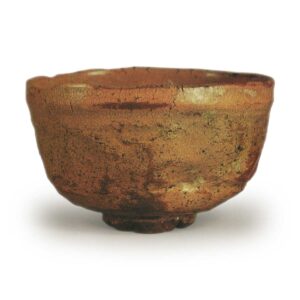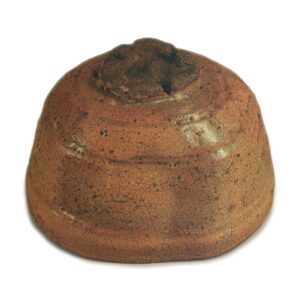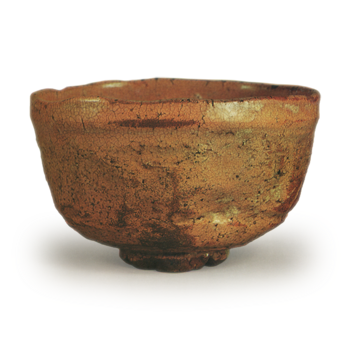

Height: 8.5-8.6cm
Diameter: 12.7-14.0cm
Foot diameter: 5.5cm
Height: 1.1cm
Hagi ware has a high reputation among Japanese tea bowls, as can be seen from the fact that it has been called “Ichiraku, Nihagi, San Karatsu” (meaning “first Ichiraku, second Hagi, third Karatsu”) by tea masters since ancient times, and there are many tea bowls on the market that are called Hagi. However, despite the fact that Hagi ware is so well known, the name of Hagi ware tea bowls is hardly mentioned in famous records of famous wares from the early Edo period onwards. It is a strange type of pottery that is widely known but has no famous tea bowls. In other words, it is a type of pottery that should be called a legendary famous kiln.
The most reliable Hagi ware tea bowl is the one with the name “Korekaibo” that was passed down in the Yabuuchi family in Kyoto. On the front of the lid of the box, there is a note written by the 5th generation Shochi Chikushin, who is considered to be the founder of the Yabuuchi family, that says “Korekaibo tea bowl, which came from Oribe”. According to this, Koreikai-bo was recognized as having come from Furuta Oribe to the first generation Kenchū, and therefore the tea bowl can be dated to the late Keichō period. Kenchū’s wife was Oribe’s daughter, and because of this relationship, the Tsuinaike family inherited many tea utensils from Oribe, including the Tsubouchi-an tea room, and it is thought that the inscription on the Kokeibo tea bowl is also reasonable.
By recognizing Korekaibo as a representative tea bowl from the Hagi ware of the founding period, and using it as a standard example, we can infer the firing dates of other tea bowls, and today, among the Hagi ware tea bowls , the most highly regarded of the Hagi tea bowls, is not quite as bold as the Kokei-bo tea bowl, but there are many similarities in the style of the two, and it is thought that they were probably both made in the early Edo period. However, some researchers believe that they were made in the middle of the Edo period or later, so the exact date of their creation must be left for future research.
Otono is a fine example of a sakura-takadai tea bowl, and although the workmanship is quite artificial, it still manages to convey a sense of size and strength, and the name of the bowl, which is a variant of the waribotai shape, is reminiscent of the petals of a cherry blossom, and although it may be said that the workmanship is excessive, it does not feel overly annoying.
A single-tiered handle is wrapped around the waist, and irregular beveled handles are wrapped around the body, with a dent in part of the body and a further indentation around the mouth. Horizontal handles are also applied to the rim of the mouth, creating a change in height. The inside is deep and wide, but a swastika-shaped line carving appears in the center, and the overall shape is relatively thinly made on the potter’s wheel. The entire piece is covered in a crackled, yellowish-green glaze, but the glaze is well-blended and soft, and the clay of the foot is sticky and fine, with a high iron content.
In addition to this tea bowl, there are others in the collection of the Fujita Museum of Art and in the collection of a certain family in Gifu, and the “Tagonoura” tea bowl listed in the Taisho Meiki Kan (A Guide to Famous Tea Bowl of the Taisho Period) is also known, but the number of these tea bowls is extremely small, and it is thought that they were probably not mass-produced. All of them have something in common with Korai-bo, and they also have a similar appearance to Gosomaru, so it can be said that they were influenced by Oribe’s taste.
On the lid of the paulownia box, the words “Haki Otono” are written in ink, and the writer is the former owner, Roka Hirase. The box was passed down from Roka to the Juntendo Tsumura family, and then to the current owner.



